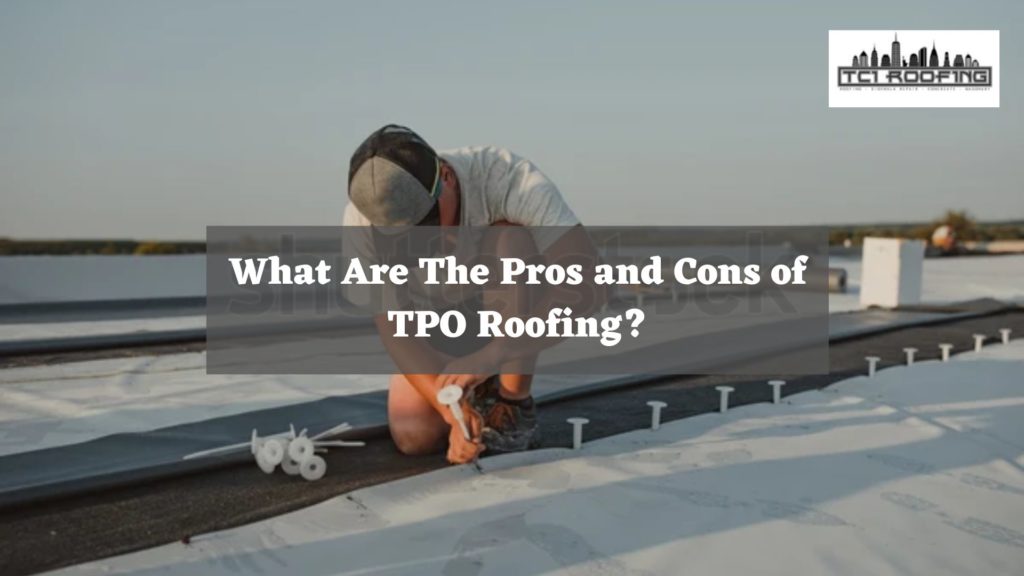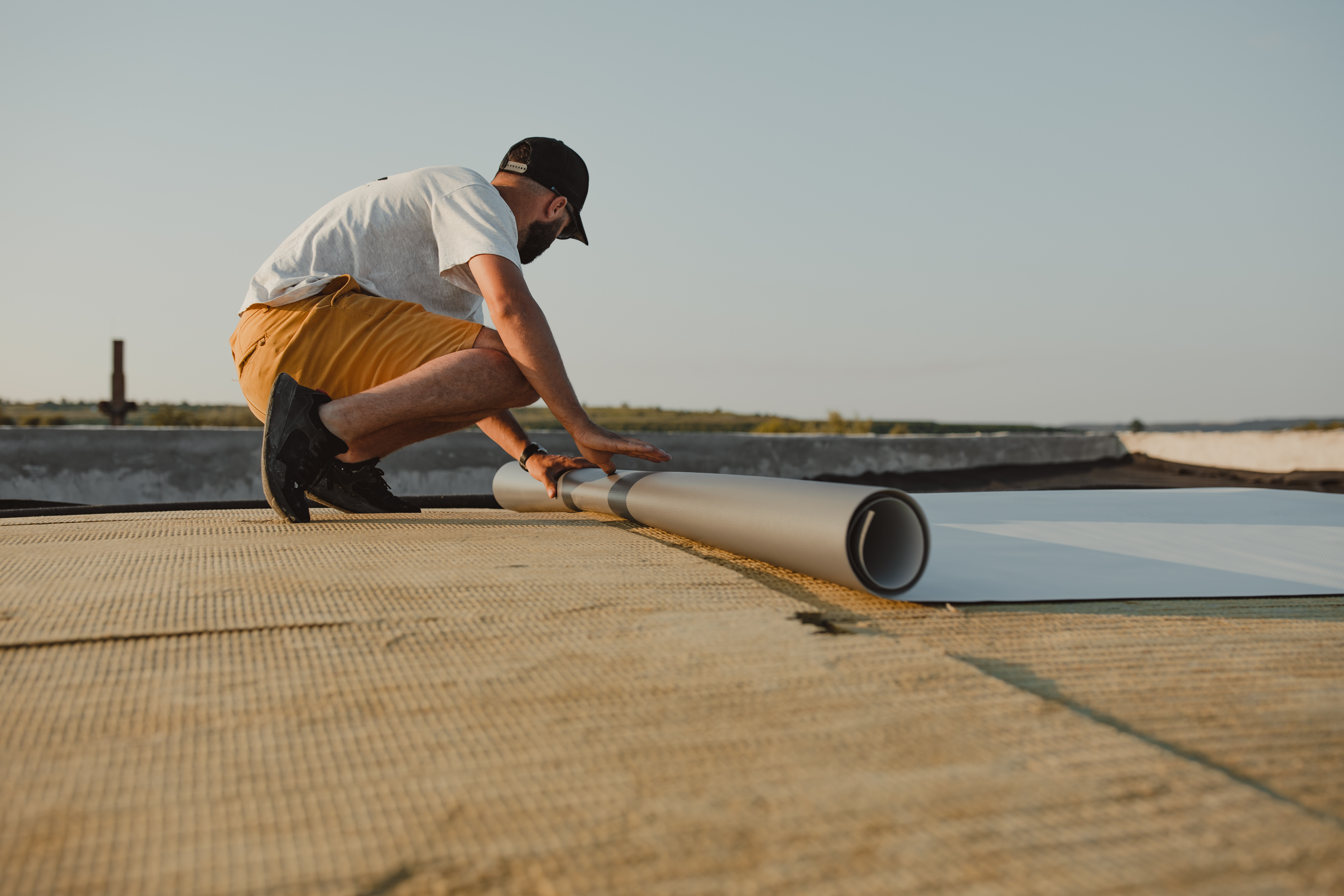Property owners are becoming increasingly enamored with TPO roofing, a lightweight, reflective roof. Thermoplastic polyolefin, sometimes known as TPO roofing, is less expensive than its two rivals, EPDM and PVC roofing. TPO roofs have their own set of disadvantages, just like any other kind of roofing material. When choosing a new roof, consider a TPO roof’s benefits and drawbacks.
TPO roofs are made of a mixture of several rubber kinds, such as polypropylene and ethylene-propylene, rather than plastic.
Three layers make up the thermoplastic polyolefin membrane:
- A TPO polymer base.
- A scrim (polyester-reinforced fabric middle)
- An upper ply constructed of thermoplastic polyolefin compound
The single-ply roofing membrane completely encircles the roof’s surface.

Why is TPO Roofing Popular?
TPO roofs are a newer technology and boast many advantages over other types of commercial roofing. For starters, TPO is exceptionally lightweight, so it can often be installed without having to reinforce the building’s structure. Another advantage of TPO is that it’s reflective, which helps keep the building cooler in the summertime. This can reduce energy costs associated with air conditioning. TPO flat roofs is also straightforward to repair. Damaged sections can be patched or replaced without replacing the entire roof.
How Does the TPO Roofing System Save Money?
Since TPO is reflective, it helps deflect the sun’s rays and keeps the building cooler. This can lead to lower energy costs for air conditioning in the summertime. TPO roofing costs can save money over time because repairs are simple. Without a roof, a building serves no purpose, it is a simple reality. Like a building needs walls, the flat roof is one of the essential components. It can be challenging to decide which roof would be best for residential roofing because so many options are available. Although there is no perfect roof, some are built to reduce costs. TPO roofing membrane and TPO roofing systems are one of these kinds of roofs.
What Are The Pros of TPO Roofing?
Some of the advantages of TPO roofs are:
- They are lightweight: TPO roofs are one of the lightest commercial roofing systems.
- They are reflective: TPO roofs reflect sunlight, which helps keep the building cooler in the summertime. This can lead to lower air conditioning costs.
- They are easy to repair: damaged sections of TPO roofs can be patched or replaced without replacing the entire roof.
They are environmentally friendly: TPO roofs do not contain PVC, a type of plastic that can release harmful chemicals into the environment.
What Are the Cons of TPO Roofing?
TPO roofs are not without their disadvantages. Some of the cons of TPO roofs are:
- They are susceptible to punctures: TPO roofs can be punctured by sharp objects, such as tree branches or hail.
- They can be damaged by heat: TPO roofs can be damaged by heat from welding torches or other sources of high heat.
- They can be slippery: TPO roofs can be tricky when wet, leading to accidents.
- They are not as durable as other roofing materials: TPO roofs generally have a shorter lifespan than EPDM or PVC roofs with single-ply membrane roofing or flat roof system.
TPO roofs have many advantages, but they also have some disadvantages. Therefore, property owners should weigh the pros and cons of TPO roofs before deciding.
What Are the Different TPO Roofing Repair Options?
TPO roofs are easy to repair, which is one of their advantages. Damaged sections can be patched or replaced without replacing the entire roof. Some of the different TPO roofing repair options are:
Patching: This involves repairing a small damaged area with a piece of TPO membrane.
Heat welding: This involves using a heat welding gun to fuse two pieces of TPO membrane.
Replacing a section: This involves removing the damaged area of the roof and installing a new piece of TPO membrane.
Installing a new TPO roof is the last resort option and should only be done if the entire roof is damaged beyond repair.
TPO roofs have many advantages, but they also have some disadvantages. Therefore, property owners should weigh the pros and cons of TPO roofs before deciding.
What Are the Different Types of TPO Roofing?
TPO roofing are available in two different types: single-ply and modified bitumen.
Single-ply: Single-ply TPO roofs are made from a single layer of TPO membrane. This type of roof is easy to install and repair.
Modified bitumen: Modified bitumen TPO roofs are made from a layer of TPO membrane and a layer of asphalt. This type of roof is more durable than single-ply roofs but is more difficult to install and repair.
TPO roofs have many advantages, but they also have some disadvantages. Therefore, property owners should weigh the pros and cons of TPO roofs before deciding.
TPO roofs are available in various colors, including white, tan, grey, and black. The color of the roof can affect the temperature inside the building. A light-colored roof will reflect sunlight and keep the building cooler in the summertime. A dark-colored roof will absorb sunlight and keep the building warmer in the wintertime.
Is TPO Roofing the Right Choice for You?
TPO roofs have many advantages, but they also have some disadvantages. Therefore, property owners should weigh the pros and cons of TPO roofs before deciding. If you are looking for a roof that is easy to install and repair, has a reflective surface, and is environmentally friendly, then TPO roofing may be the right choice. However, if you are looking for a more durable roof with a longer lifespan, you may want to consider another type of roofing material.
How to Choose a TPO Roofing Company?
When choosing a TPO roofing company, it is essential to choose one that is experienced and has a good reputation. You should also ensure that the company you choose offers a warranty on their work. Here are some tips on how to select a TPO roofing company:
Do your research: Before choosing a roofing company, do your research to ensure they are experienced and have a good reputation. You can read online reviews or ask your friends and family for recommendations.
Get multiple quotes: When you have narrowed down your choices, get various quotes from different companies. This will help you compare prices and find the best deal and the TPO roofing cost per square foot.
Ask about warranties: Make sure the company you choose offers a warranty on their work. This will protect you in case something goes wrong with the roof.
Choosing the right TPO roofing company is vital to ensure that your roof is installed correctly and will last for years.
Thoughts
TPO roofing are a newer technology and boast many advantages over other types of commercial roofing. For starters, TPO is exceptionally lightweight, so it can often be installed without having to reinforce the building’s structure. TPO roofs have many advantages, but they also have some disadvantages. Therefore, property owners should weigh the pros and cons of TPO roofs before deciding. When choosing a TPO roofing company, it is essential to choose one that is experienced and has a good reputation. You should also ensure that the company you choose offers a warranty on their work. Choosing the right TPO roofing company is vital to ensure that your roof is installed correctly and will last for years.



